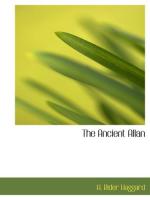which we built at a place in the desert, not far
from the banks of the Nile, about half way between
Luxor which was the ancient Thebes, and Assouan.
George took a great fancy to this spot when first
he saw it, and so in truth did I, for, like Memphis,
it attracted me so much that I used to laugh and
say I believed that once I had something to do with
it.
“Now near to our villa that we called ‘Ragnall’ after this house, are the remains of a temple which were almost buried in the sand. This temple George obtained permission to excavate. It proved to be a long and costly business, but as he did not mind spending the money, that was no obstacle. For four winters we worked at it, employing several hundred men. As we went on we discovered that although not one of the largest, the temple, owing to its having been buried by the sand during, or shortly after the Roman epoch, remained much more perfect than we had expected, because the early Christians had never got at it with their chisels and hammers. Before long I hope to show you pictures and photographs of the various courts, etc., so I will not attempt to describe them now.
“It is a temple to Isis—built, or rather rebuilt over the remains of an older temple on a site that seems to have been called Amada, at any rate in the later days, and so named after a city in Nubia, apparently by one of the Amen-hetep Pharaohs who had conquered it. Its style is beautiful, being of the best period of the Egyptian Renaissance under the last native dynasties.
“At the beginning of the fifth winter, at length we approached the sanctuary, a difficult business because of the retaining walls that had to be built to keep the sand from flowing down as fast as it was removed, and the great quantities of stuff that must be carried off by the tramway. In so doing we came upon a shallow grave which appeared to have been hastily filled in and roughly covered over with paving stones like the rest of the court, as though to conceal its existence. In this grave lay the skeleton of a large man, together with the rusted blade of an iron sword and some fragments of armour. Evidently he had never been mummified, for there were no wrappings, canopic jars, ushapti figures or funeral offerings. The state of the bones showed us why, for the right forearm was cut through and the skull smashed in; also an iron arrow-head lay among the ribs. The man had been buried hurriedly after a battle in which he had met his death. Searching in the dust beneath the bones we found a gold ring still on one of the fingers. On its bezel was engraved the cartouche of ’Peroa, beloved of Ra.’ Now Peroa probably means Pharaoh and perhaps he was Khabasha who revolted against the Persians and ruled for a year or two, after which he is supposed to have been defeated and killed, though of his end and place of burial there is no record. Whether these were the remnants of Khabasha himself, or of




